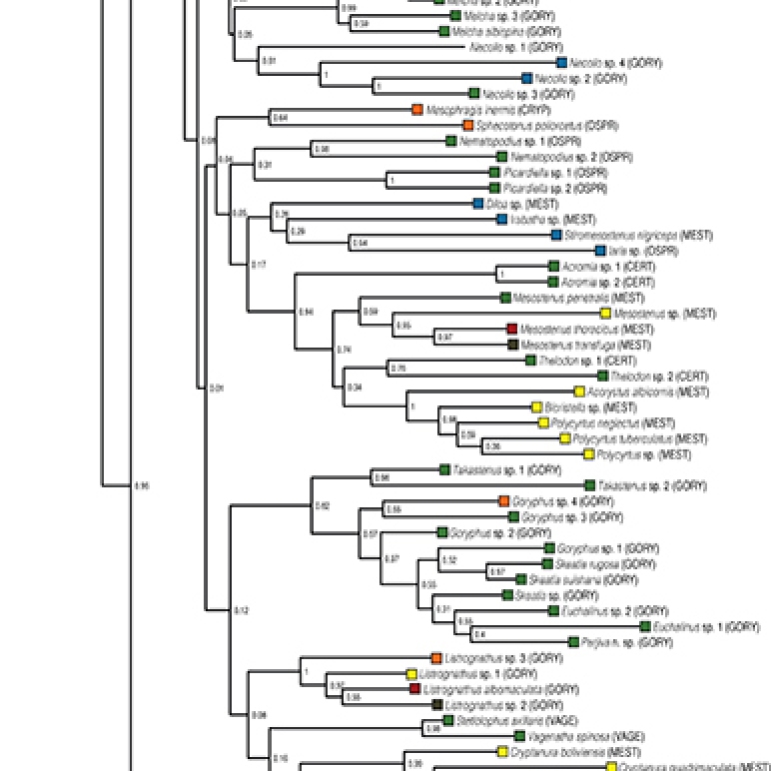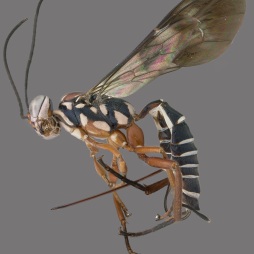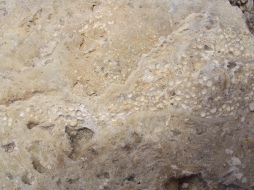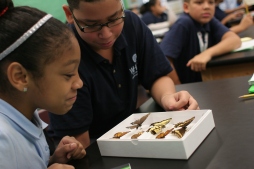Hello! I’m a biologist and biodiversity researcher at the Museum für Naturkunde in Berlin.
Here you can find some of my work, including ongoing projects, recent achievements and scientific output.
About
I am a research biologist interested in the biodiversity and evolution of insects, in particular a very special group of insects: parasitic wasps.
I finished my Ph.D. in Comparative Biology at the American Museum of Natural History in 2016 and worked as a postdoctoral fellow at the Smithsonian’s National Museum of Natural History and as curator of Hymenoptera at the Muséum National d’Histoire Naturelle in Paris. Now, I am a researcher at the Museum für Naturkunde in Berlin. My interests are broad and range from cataloging and describing the impressive biodiversity of parasitic wasps to elucidating broader evolutionary questions related to themes such as morphological diversification, species limits, evolution and significance of color patterns and global patterns of wasp diversity. In order to address these issues, my research encompasses several components from the fieldwork in rainforests to collection rooms with thousands of specimens, microscopes and cameras, molecular biology laboratories and computer clusters.
I am also passionate about science education and have worked in outreach and education with students from middle school to graduate level.
This website presents some of my work, including ongoing projects, recent achievements and scientific output. For more detailed information, check out my CV.
Research
My research interests are centered on the evolution of one of the most diverse and ecologically important groups of organisms on Earth: the ichneumonid parasitic wasps (Hymenoptera, Ichneumonidae). I am particularly interested in the processes that generated the impressive diversity of life history strategies, morphological adaptations and ecological traits seen in these wasps. My work to elucidate these questions combines a robust phylogenetic framework with statistical tools such as phylogenetic comparative methods and geometric morphometrics. In the process of investigating these issues, I also invest in unraveling the largely unexplored wasp biodiversity, conducting projects of revisionary systematics and describing new species.

Integrating genomics and geometric morphometrics to unravel the diversification of parasitic wasps
My main research project aims at unraveling the impact of convergent life strategies on the phenotypic evolution in a hyperdiverse lineage of parasitic wasps. Genomic data from ultraconserved elements (UCEs) are combined with phenotypic data collected and analyzed with geometric morphometrics to study evolutionary pathways in the morphospace and elucidate the constraints in morphology posed by convergent evolution.
In my current research, I integrate molecular and phenotypic data to reconstruct changes in host use across lineages of parasitic wasps; to identify correlation between phenotypes and particular life strategies (the use of a specific host taxon or the timing of parasitization, for example); and to quantify the overlap in the morphospace among lineages with similar life history. The goal is to lead to a better understanding of the role of parasitism life strategies in shaping phenotypes and of the constraints in morphology posed by convergent evolution.
Systematics of cryptine wasps (Hymenoptera, Ichneumonidae, Cryptini)
This is my primary and most basic line of research. Since the beginning of my career, I have been dedicated to understand the evolutionary history of Cryptini and describe and classify the biodiversity of this hyperdiverse group of wasps. Since 2008, I have described 115 new species and three new genera, and many more new species are identified and waiting to be described! I also use molecular and morphological data to investigate the evolutionary history of cryptines and other ichneumonid groups, a line of work that serves as a basis to the broader evolutionary and ecological aspects of my research.
Morphological diversification
One of my main research interests is the study of phenotypic adaptations, particularly convergent evolution. In the past, I have focused on the evolutionary pathway of adaptations related to finding and assessing deeply concealed hosts by cryptine wasps. I used comparative methods and geometric morphometrics in a phylomorphospace approach to advance the idea that these adaptations are part of a complex morpho-functional system, and to show how that affects the evolution of body shape in the associated lineages. I have now expanded this investigation to other ichneumonid lineages and other types of life strategies, such as the developmental stage of the host attacked by different groups of wasps.
Ichneumonid phylogenomics
Thanks to funding granted by the Global Genome Initiative, I am currently leading a project aiming at reconstructing the phylogeny of the whole family Ichneumonidae using data from genomic ultraconserved elements (UCEs; http://ultraconserved.org/). Ichneumonid parasitic wasps comprise one of the largest insect lineages, but the lack of a comprehensive phylogeny currently hinders our understanding of their diversification process. Our project combines the efforts and expertise of multiple researchers throughout the world with an unprecedented genomic dataset to generate a powerful phylogenetic framework. UCE data is currently being harnessed to generate a phylogeny of 800+ species. Total-evidence dating with a rich fossil sampling will be used to date the tree, putting ichneumonid diversification into temporal context, and the evolution of biological traits will be assessed through ancestral state reconstructions.
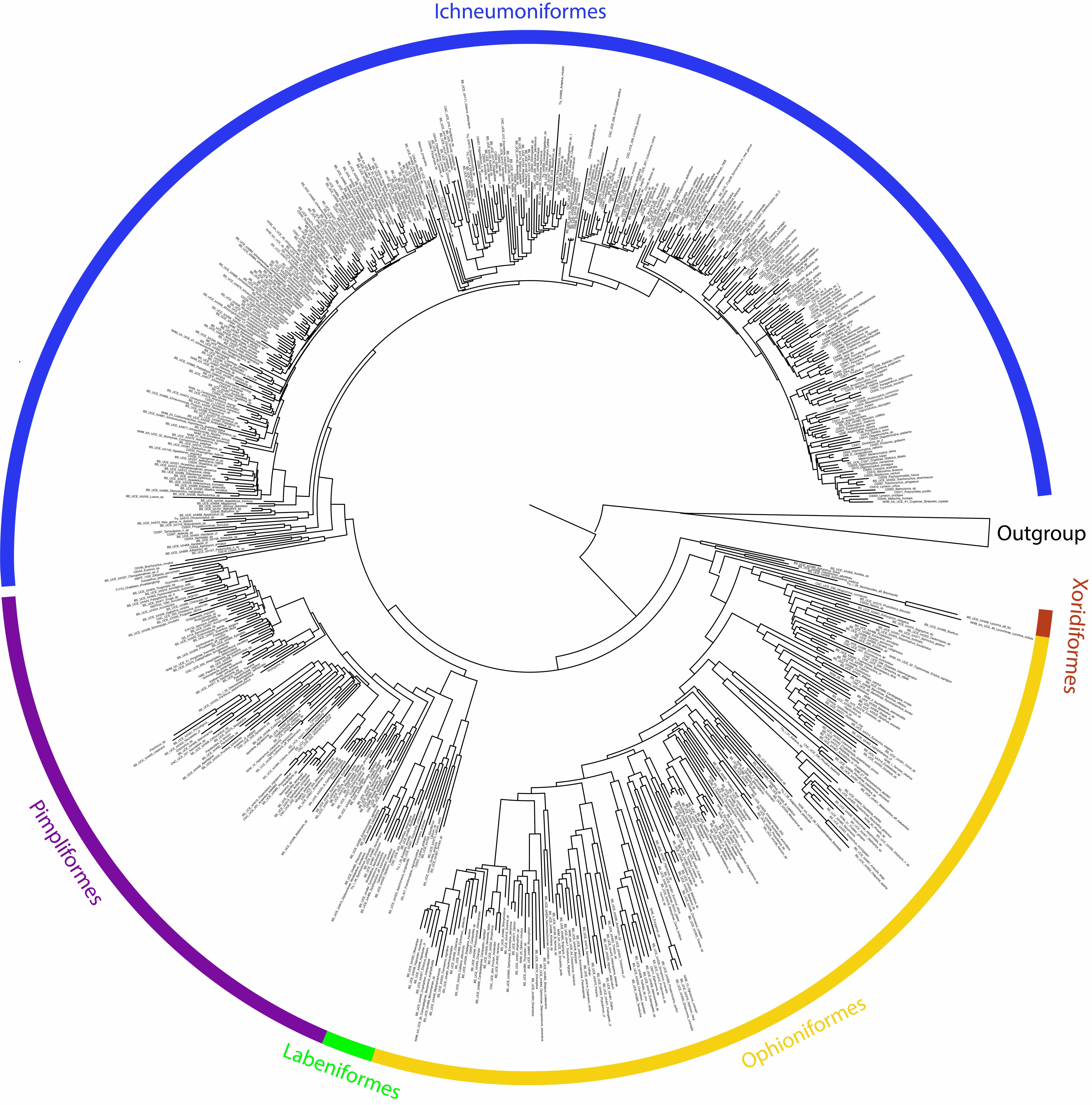
Sequencing and annotating whole genomes
The most recent expansion of my research program involves using functional genomics to elucidate key aspects of the diversification of parasitic wasps. I have been investigating the relationship between some groups of parasitic wasps and viral symbionts that help to disable the immune system of their hosts. These viruses, called polydnaviruses, have been “domesticated” independently by two diferente groups of parasitic wasps, the Braconidae and the Ichneumonidae. Previous research has shown that the whole viral genomes are incorporated into the wasp’s DNA, and I have been working on mapping these viral insertions in a comparative framework. To that end, I have sequenced the whole genome of the ichneumonid wasp Campoletis sonorensis. I have been collaborating with researchers from the Institut National de la Recherche Agronomique in France to compare the distribution of viral segments between C. sonorensis and another wasp species, Hyposoter didymator. We have found that sequences from the viral genome are scattered across the wasp genome, in contrast with the viruses found in Braconidae, which are clustered in large blocks. We have also found that elements of the viral genome that are functionally different also show different degrees of conservation between the two ichneumonid wasps. The proviral genes that help to destroy the host immune response are species-specific, as they need to be fine-tuned to host physiology. Meanwhile, the viral elements related to particle production and replication are conserved, likely reflecting the genomic architecture of the ancestral vírus. The results have recently been published at BMC Biology!
Upcoming: more genomes!
Thanks to a grant from the Smithsonian, we were recently able to sequence whole genome data for 100+ ichneumonid species. We now plan to look at the diversity in genes associated with key biological processes and test if these are correlated with life strategy traits such as endo- versus ectoparasitism, host specificity and developmental stage. We will also test if independent lineages with the same hosts convergently evolve similar peptide profiles. The results will be used to test current hypotheses about ichneumonid diversification; they will also make the Ichneumonidae one of the best-characterized groups of insects from a genomic perspective!
Other ongoing projects and interests include:
- Color patterns: Cryptines display an impressive variety of color patterns, which seem to show a pattern of convergence across lineages. I am investigating the phylogenetic and geographic signals shown in color patterns in a group of cryptine wasps and what these patterns can tell us about evolutionary processes.

- Surveys and inventories: Only by continuously documenting species occurrence we can draw a truly informative picture of Earth’s biodiversity and understand which environmental factors help to shape communities and ecosystems. In partnership with colleagues, I am involved in several surveys and community ecology studies throughout the Neotropics.
Fieldwork
Working in the field is a fundamental component of my research and my life. I have extensive field experience in environments throughout South America, from the lush Amazonian Forest to the arid habitats of Central Chile. I am continuously seeking opportunities for fieldwork and the external funding to support these initiatives.
Publications
Articles published in scientific journals
- Blaimer, B., Santos, B.F., Cruaud, A., Gates, M.W., Kula, R.R., Mikó, I., Rasplus, J-Y., Smith, D.R., Talamas, E.J., Brady, S.G. & Buffington, M.L. 2023. Key innovations and the diversification of Hymenoptera. Nature Communications, 14: 1212. [PDF]
- Mathou, A., Wahl, D.B., Quentell, U., Claridge, B. & Santos, B.F. 2023. Sexual dimorphism in ichneumonine parasitic wasps (Hymenoptera: Ichneumonidae: Ichneumoninae) and the neglected influence of the ecological niche. Biological Journal of the Linnean Society.
- Levesque-Beaudin, V., Miller, M.E., Dikow, T., Miller, S.E., Prosser, S.W.J., Zakharov, E.V., McKeown, J.T.A., Sones, J.E., Redmond, N.E., Coddington, J.A., Santos, B.F., Bird, J. & deWaard, J.R. A workflow for expanding DNA barcode reference libraries through ‘museum harvesting’ of natural history collections. Biodiversity Data Journal, 11:e100677. [PDF]
- Santos, B.F., Miller, M.E., Miklasevskaja, M., McKeown, J.T.A., Redmond, N.E., Coddington, J.A., Bird, J., Miller, S.E., Smith, A., Brady, S.G., Buffington, M.L., Chamorro, M.L., Dikow, T., Gates, M.W., Goldstein, P., Konstantinov, A., Kula, R., Silverson, N.D., Solis, M.A., deWaard, S.L., Naik, S., Nikolova, N., Pentinsaari, M., Prosser, S.W.J., Sones, J.E., Zakharov, E.V., deWaard, J.R. 2023. Enhancing DNA barcode reference libraries by harvesting terrestrial arthropods at the Smithsonian`s National Museum of Natural History. Biodiversity Data Journal, 11: e100904. [PDF]
- Neves, K., Santos, B.F., Schultz, T., Gotzek, D., Abreu, R.C.R., Durigan, G. & Vasconcelos, H.L. 2023. Woody encroachment affects multiple dimensions of ant diversity in a neotropical savanna. Insect Conservation and Diversity, 16:393–402. https://doi.org/10.1111/icad.12633.
- Supeleto, F.A., Santos, B.F. & Aguiar, A.P. 2022. Revision of Fortipalpa Kasparyan & Ruíz-Cancino, (Ichneumonidae, Cryptinae). Zootaxa, 5219:501-533.
- Santos, B.F., Sandoval, M., Spasojevic, T., Giannotta, M.M. & Brady, S.G. 2022. A Parasitoid Puzzle: Phylogenomics, Total-evidence Dating, and the Role of Gondwanan Vicariance in the Diversification of Labeninae (Hymenoptera, Ichneumonidae). Insect Systematics and Diversity, 6(5): 1-13. DOI: 10.1093/isd/ixac015 [PDF]
Jasso-Martínez, J.M.*, Santos, B.F.*, Zaldívar-Riverón, A., Fernández-Triana, J.L., Sharanowski, B.J., Richter, R., Dettman, J.R., Blaimer, B.B. Brady, S.G. & Kula, R.R. 2022. Phylogenomics of braconid wasps (Hymenoptera, Braconidae) sheds light on classification and the evolution of parasitoid life history traits. Molecular Phylogenetics and Evolution, 173:107452. https://doi.org/10.1016/j.ympev.2022.107452 [PDF] (*co-first authors)- Jasso-Martínez, J.M., Quicke, D.L.J., Belokobylskij, S.A., Santos, B.F., Fernández-Triana, J.L., Kula, R.R. & Zaldívar-Riverón, A. 2022. Mitochondrial phylogenomics and mitogenome organization in the parasitoid wasp family Braconidae (Hymenoptera: Ichneumonoidea). BMC Ecology and Evolution, 22:46, https://doi.org/10.1186/s12862-022-01983-1 [PDF]
- Pádua, D.G., Kloss, T.G., Tavares, M.T., Santos, B.F., Araújo, R.O., Schoeninger, K., Sobczak, J.F. & Gonzaga, M.O. 2022. Hyperparasitoids of polysphinctine Darwin wasps (Hymenoptera: Ichneumonidae) in South America. Austral Entomology, 61:170-186.
- Bordera, S. & Santos, B.F. 2022. A review of Piasites Seyrig (Hymenoptera, Ichneumonidae, Cryptinae), with description of seven new species. Journal of Hymenoptera Research, 90:23–57.[PDF]
- Santos, B.F.*, Klopfstein, S.*, Whitfield, J.B.* & Sharanowski, B.J.* 2022. Many evolutionary roads led to virus domestication in ichneumonoid parasitoid wasps. Current Opinion in Insect Science, 50:100861. [PDF] (*co-first authors)
Samacá-Sáenz, E., Santos, B.F., Martínez, J.J., Egan, S.P., Shaw, S.R., Hanson, P.E. & Zaldívar-Riverón, A. 2022. Ultraconserved elements-based systematics reveals evolutionary patterns of host-plant family shifts and phytophagy within the predominantly parasitoid braconid wasp subfamily Doryctinae. Molecular Phylogenetics and Evolution, 166: 107319. [PDF]
Santos, B.F., Wahl, D.B., Rousse, P., Bennett, A.M.R., Kula, R. & Brady, S.G. 2021. Phylogenomics of Ichneumoninae (Hymenoptera, Ichneumonidae) reveals pervasive morphological convergence and the shortcomings of previous classifications. Systematic Entomology, 46: 704–724. [PDF]
Supeleto, F.A., Aguiar, A.P. & Santos, B.F. 2021. A new species, key and further redefinition of Nesolinoceras Ashmead (Hymenoptera, Ichneumonidae, Cryptinae). Zootaxa, 5016: 107–116.[PDF]- Somavilla, A., Santos, B.F., Carpenter, J.M., Andrena, S.R. & Oliveira, M.L. 2021. Total-evidence phylogeny of the New World Polistes Lepeletier, 1836, paper wasps (Vespidae, Polistinae, Polistini). American Museum Novitates, 3973: 1–42. [PDF]
Sandoval, M. & Santos, B.F. 2021. A new species of Grotea Cresson, the first record of Labeninae (Hymenoptera, Ichneumonidae) in the Greater Antilles. Journal of Hymenoptera Research, 81: 1–8. [PDF]- Legeai, F*., Santos, B.F.*, Robin, S.*, Breteaudeau, A., Dikow, R., Lemaitre, C., Jouan, V., Ravallec, M. Drezen, J.M., Tagu, D., Gyapay, G., Zhou, X., Liu, S., Webb, B., Brady, S.G. & Volkoff, A.N. 2020. Genomic architecture of endogenous ichnoviruses reveals distinct evolutionary pathways leading to virus domestication in parasitic wasps. BMC Biology, 18:89. [PDF] (*co-first authors)
- Supeleto, F.A., Santos, B.F., Basílio, L.A. & Aguiar, A.P. 2020. Species delimitation, environmental cline and phylogeny for a new Neotropical genus of Cryptinae (Ichneumonidae). PLoS ONE, 15(10): e0237233. DOI: 10.1371/journal.pone.0237233. [PDF]
- Supeleto, F.A., Santos, B.F. & Aguiar, A.P. 2020. A new species and southernmost record of Cestrus Townes (Hymenoptera, Ichneumonidae, Cryptinae). Zootaxa, 4822: 277–284 [PDF]
- Supeleto, F.A., Santos, B.F. & Aguiar, A.P. 2020. Phylogenomic analyses reveal a rare new genus of wasp (Hymenoptera, Ichneumonidae, Cryptinae) from the Brazilian Atlantic Forest. Systematics and Biodiversity, 1–16. [PDF]
- Klopfstein, S., Santos, B.F., Shaw, M.R., Alvarado, M., Bennett, A.M., Dal Pos, D., Giannotta, M., Herrera-Florez, A.F., Karlsson, D., Khalaim, A.I., Lima, A.R., Mikó, I., Sääksjärvi, I. E., Shimizu, S., Spasojevic, T., van Noort, S., Vilhelmsen, L., & Broad, G. R. 2019. Darwin wasps: a new name heralds renewed efforts to unravel the evolutionary history of Ichneumonidae. Entomological Communications, 1: ec01006. DOI:10.37486/2675-1305.ec01006 [PDF]
- Reshchikov, A., Santos, B.F., Liu, J.X. & Barthélémy, C. 2019. Review of Palpostilpnus Aubert (Hymenoptera, Ichneumonidae, Phygadeuontinae), with the description of ten new species. European Journal of Taxonomy, 582: 1–63. DOI: 10.5852/ejt.2019.582 [PDF]
- Supeleto, F.A., Santos, B.F. & Aguiar, A.P. 2019. Revision of Distictus Townes, 1966 (Hymenoptera, Ichneumonidae, Cryptinae), with descriptions of ten new species. European Journal of Taxonomy, 542: 1–64. DOI: 10.5852/ejt.2019.542. [PDF]
- Santos, B.F., Perrard, A. & Brady, S.G. 2019. Running in circles in phylomorphospace: host environment constrains morphological diversification in parasitic wasps. Proceedings of the Royal Society B: Biological Sciences, 286:20182352. [PDF]
Santos, B.F., Alvarado, M., Sääksjärvi, I.E., van Noort, S., Villemant, C. & Brady, S.G. 2018. Molecular phylogeny of Ateleutinae (Hymenoptera: Ichneumonidae): systematics and biogeography of a widespread parasitoid wasp lineage. Zoological Journal of the Linnean Society, 1–22. DOI: 10.1093/zoolinnean/zly072. [PDF]
- Araújo, R.O., Vivallo, F. & Santos, B.F. 2018. Ichneumonid wasps of the subfamily Mesochorinae: new replacement names, combinations and an updated key to the World genera (Hymenoptera: Ichneumonidae). Zootaxa, 4521:52–60. DOI: 10.11646/zootaxa.4521.1.2. [PDF]
- Santos, B.F. & Perrard, A. 2018. Testing the Dutilleul syndrome: host use drives the convergent evolution of multiple traits in parasitic wasps. Journal of Evolutionary Biology, 31:1430–1439. DOI: 10.1111/jeb.13343. [PDF]
- Santos, B.F. & Hoppe, J.P.M. 2018. Filling gaps in species distributions through the study of biological collections: 415 new distribution records for Neotropical Cryptinae (Hymenoptera, Ichneumonidae). Revista Brasileira de Entomologia, 62:288–291. DOI: 10.1016/j.rbe.2018.09.001. [PDF]
- Santos, B.F., Scherrer, M.V. & Loss, A.C. 2018. Neither barriers nor refugia explain genetic structure in a major biogeographic break: phylogeography of praying mantises in the Brazilian Atlantic Forest. Mitochondrial DNA Part A, 29:1284–1292 DOI: 10.1080/24701394.2018.1445242. [PDF]
- Santos, B.F. & Aguiar, A.P. 2018. Review of Dotocryptus Brèthes (Hymenoptera, Ichneumonidae, Cryptinae), with a New Species from Colombia. Neotropical Entomology, 47:871–844. DOI 10.1007/s13744-018-0602-y. [PDF]
- Araújo, R.O., Vivallo, F. & Santos, B.F. 2018. Discovery of two new Andean species of Scolomus (Townes), with a key to all known species (Hymenoptera: Ichneumonidae: Metopiinae). Zootaxa, 4429: 189–194. DOI: 10.11646/zootaxa.4429.1.12 [PDF]
- Santos, B.F. 2017. Phylogeny and reclassification of Cryptini (Hymenoptera, Ichneumonidae, Cryptinae), with implications for ichneumonid higher-level classification. Systematic Entomology, 42:650–676. DOI 10.1111/syen.12238. [PDF]
Santos, B.F., Aguiar, A.P., Tedesco, A.M. & Fontenelle, J.C.R. 2017. Long-term seasonal dominance of the wasp Trihapsis polita Townes (Hymenoptera, Ichneumonidae) in the Brazilian Atlantic Forest. Biodiversity Data Journal, 5, e11337. [PDF]
- Santos, B.F. 2016. Generic redefinition and a new species of Nesolinoceras (Hymenoptera, Ichneumonidae, Cryptinae). American Museum Novitates, 3858: 1–16. [PDF]
- Villanueva-Bonilla, G.A., Onody, H.C., Santos, B.F. & Vasconcelos-Neto, J. 2016. First record of egg sac predation on a wall crab spider Selenopidae (Araneae) by the wasp Camera lunavenatrix n. (Ichneumonidae, Cryptinae). Journal of Hymenoptera Research, 49: 65–79. [PDF]
- Aguiar, A.P. & Santos, B.F. Revision of Melanocryptus Cameron (Ichneumonidae, Cryptinae), with description of seven new species. American Museum Novitates, 3836: 1–56. [PDF]
- Santos, B.F., Payne, A., Pickett, K.M. & Carpenter, J.M. 2015. Phylogeny and historical biogeography of the paper wasp genus Polistes (Hymenoptera: Vespidae): implications for the overwintering hypothesis of social evolution. Cladistics, 31: 535–549. [PDF]
- Santos, B.F. & Aguiar, A.P. 2015. Review of Loxopus Townes (Hymenoptera, Ichneumonidae, Cryptinae), with descriptions of six new species. Journal of Natural History, 49(31-32): 1905–1935. [PDF]
- Santos, B.F. & Aguiar, A.P. 2013. Phylogeny and revision of Messatoporus Cushman (Hymenoptera, Ichneumonidae, Cryptinae), with description of sixty five new species. Zootaxa 3634: 1–284. [PDF]
- Aguiar, A.P. & Santos, B.F. 2012. Additions to the revision of Digonocryptus Viereck (Hymenoptera, Ichneumonidae, Cryptinae), with nine new taxa, new males and distribution maps for all known species. Zootaxa, 3828: 1–41. [PDF]
- Santos, B.F., Aguiar, A.P. & Tedesco, AM. 2012. Trigonalidae (Hymenoptera) from cacao agroforestry systems in northeastern Brazil, with two new species of Trigonalys Journal of Hymenoptera Research, 25: 19–33. [PDF]
- Santos, B.F. & Aguiar, A.P. 2012. Phylogeny and description of Eknomia, a morphologically unusual new genus of Neotropical Cryptinae (Hymenoptera, Ichneumonidae, Cryptinae). Zootaxa, 3237: 35–52. [PDF]
- Aguiar, A.P. & Santos, B.F. 2010. Discovery of potent, unsuspected sampling disparities for Malaise and Möricke traps, as shown for Neotropical Cryptini (Hymenoptera, Ichneumonidae). Journal of Insect Conservation, 14: 199–2010. [PDF]
- Scherrer, M.V., Santos, B.F. & Aguiar, A.P. 2010. Generic redefinition, key and two new species of Acorystus Townes (Hymenoptera, Ichneumonidae, Cryptinae). Zootaxa, 2721: 28–38. [PDF]
- Santos, B.F., Aguiar, A.P. & Tedesco, A.M. 2009. Phylogenetic revision and the origin of Polyphrix Townes (Hymenoptera, Ichneumonidae, Cryptinae), with description of a new species. Zootaxa, 1934: 30–39. [PDF]
- Aguiar, A.P. & Santos, B.F. 2009. Biological synopsis of Photocryptus Viereck (Hymenoptera, Ichneumonidae, Cryptinae), with eight new host records and fourteen new geographic records. Zootaxa, 2148: 49–45. [PDF]
- Santos, B.F. & Aguiar, A.P. 2008. Phylogeny and reclassification of Distictus Townes (Hymenoptera, Ichneumonidae, Cryptinae), with description of a new species. Zootaxa, 1934: 30–39. [PDF]
Book chapter
Aguiar, A.P., Santos, B.F., Couri, M.S., Rafael, J.A., Costa, C. Ide, S., Duarte, M., Grazia, J., Schwertner, C.F., Freitas, A.V.L. & Azevedo, C.O. Insecta. In: Rocha, R.M. & Boeger, W.A. Estado da Arte e Perspectivas para a Zoologia no Brasil [State of Art and Perspectives to the Zoology in Brazil]. Editora UFPR, Curitiba, pp.131–155. [PDF in Portuguese]
Education and outreach
My academic career was always intrinsically tied to teaching and mentoring, and helping students to develop understanding and appreciation for scientific knowledge is a passion of mine. Over the course of the years, I have worked in education and outreach targeting publics ranging from middle schoolers to graduate students, in settings as diverse as formal lectures to undergraduates and dinners with museum board members.
Teaching in higher education
As an educator, I have led lectures, discussions, lab practice sessions, developed teaching materials, designed and graded exams for early and advanced undergraduate students. I have acted as teaching assistant for Invertebrate Zoology courses multiple times. After finishing my M.Sc. degree, I was employed as Lecturer in the University’s Department of Biological Sciences, teaching multiple courses on subjects as varied as Cell Biology and Paleontology.
Hunting fossils with undergraduate students for the Paleontology course
Mentoring high school students
During my time at the American Museum of Natural History, I was a mentor for the Science Research Mentorship Program, an ambitious initiative to involve high school students in research. I worked with two students for a whole academic year in a project of species delimitation in a widespread Andean lineages of wasps (see the Research page). In developing the project, students learned a broad set of skills, including DNA sequencing, data capture for morphometrics, bioinformatics, phylogenetics and scientific writing. The experience was clearly successful: my student Bayle Smith-Salzberg has won a Second Award in the New York City Science and Engineering Fair for the results of our project!
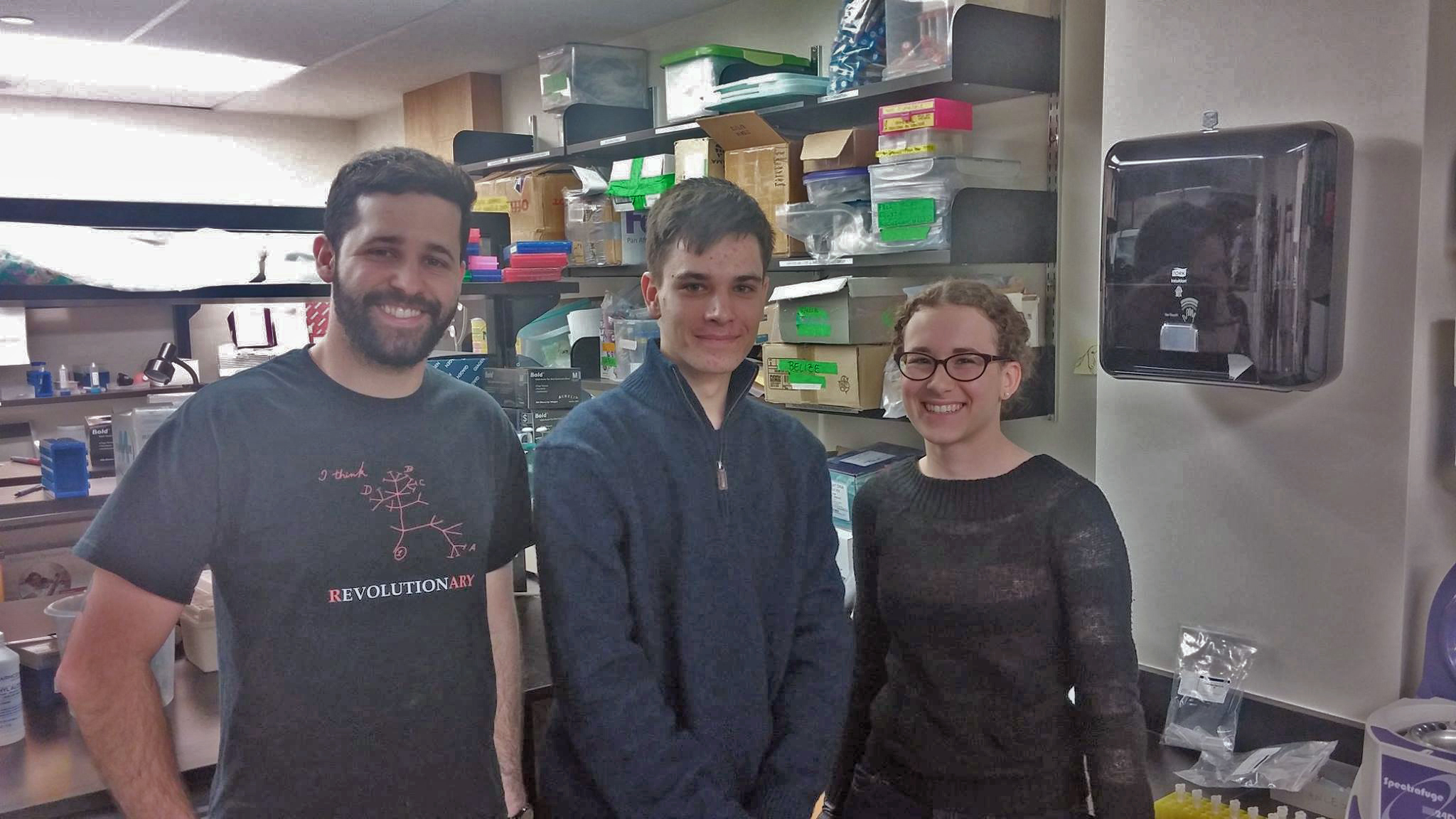
Mentoring undergraduate students
At the National Museum of Natural History, I have mentored two undergraduate students in research projects, as part of the museum’s prestigious internship programs.
Callie Levigne from Marymount University worked part-time for a whole school semester mounting, labeling and sorting specimens of Cryptinae collected at Powdermill Nature Reserve. The long-term goal of this project is to compare the biodiversity of wasps collected with two different sampling methods: Malaise traps and yellow pan traps. The idea is to compare the relative performance of both traps in tropical and temperate ecosystems, with collaborators in Brazil inputting data from long-term sampling in the Brazilian Atlantic Forest. I have a strong suspicion that sampling biases may account for at least part of the perceived reduced diversity of ichneumonids in the tropics. Almost all comparisons between tropical and temperate faunas was done using exclusively material from Malaise traps – but what if other methods of sampling tell a different story?
Marissa Sandoval from UC Berkeley worked full-time for the summer of 2019 sponsored by the NSF-sponsored program Natural History Research Experiences. Her project focused on the phylogeny and biogeography of the very cool subfamily Labeninae. This group of ichneumonids is known for having an essentially “Gondwanan” distribution, with almost all species found only in the Neotropical and Australian Regions. This have led authors to hypothesize that the group originated before the split of these two landmasses, and that the current patterns are explained by vicariance biogeohraphy. To test that hypothesis, Marissa generated a full-fledged UCE dataset for labenines, going through all steps from specimen selection and DNA extraction to targeted enrichment and next-generation sequencing. She then generated the first time-calibrated phylogenetic tree for Labeninae. We were also able to identify a new species of the labenine genus Grotea from the Dominican Republic, which she is are now describing. We hope to have both project published very soon, and Marissa will present the results of her research at the 2019 meeting of the Entomological Society of America!
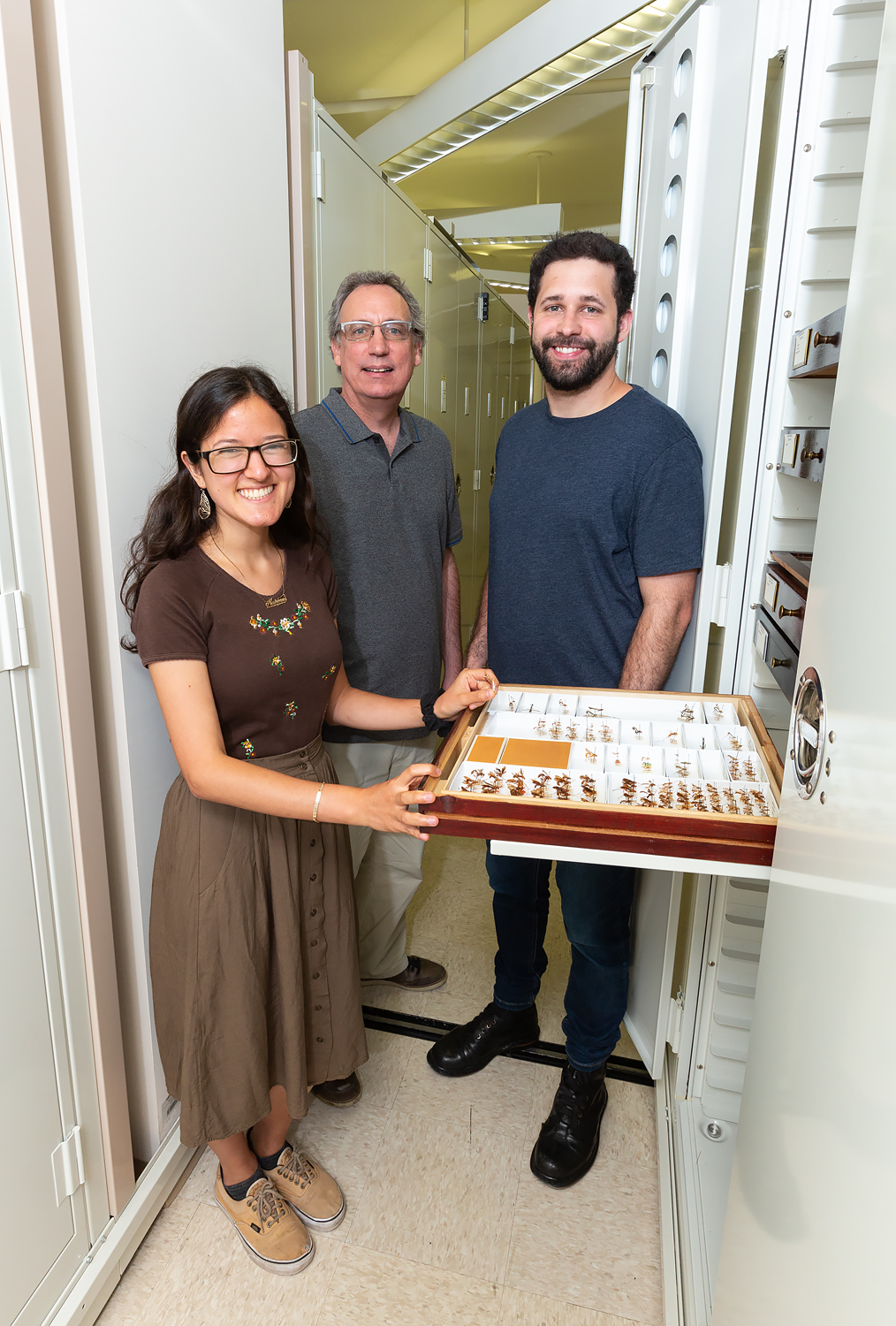
Outreach and press
Working in institutions with a strong tradition in outreach and scientific education, I was fortunate enough to participate in multiple initiatives aiming to educate the general public on science and biodiversity. My work was also featured in the news media a few times, most prominently when I enlisted sixth grade students to help me name a new species of wasp from the Dominican Republic, now named Nesolinoceras laluzbrillante, “the bright light”.
Leadership and service
Conference organization
Project managing: barcoding NMNH invertebrate genera
UCE workshop and training

Contact
Center for Integrative Biodiversity Discovery
Museum für Naturkunde
Invalidenstraße 43, 10115
Email:
bernardo.santos at mfn.berlin
bernardofsantos at gmail.com
